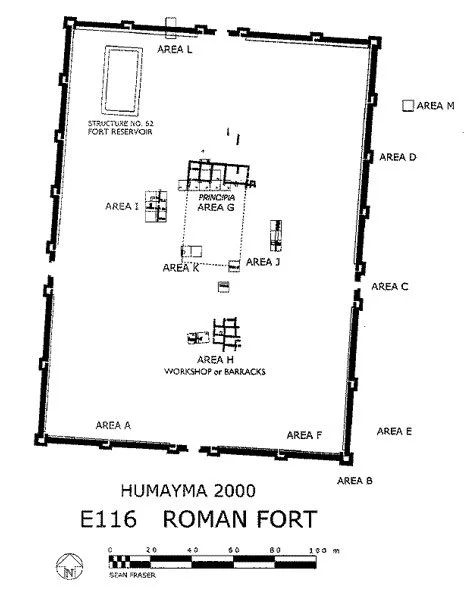Castella in Arabia
Forts are referred to by the Latin terms castellum or castra. The forts in Arabia filled in the gaps between the larger fortresses. Sometimes they were positioned to provide better observation of movements in the desert.
Plan of Kirbet al-Fityan
An example is Khirbet el-Fityan, a castellum located 1.5 km (1 mi.) northwest of the fortress el-Lejjun. It was built around the same time as el-Lejjun. The west curtain was founded on an earlier Iron Age wall. It is roughly square in shape and is 0.6 ha (1.5 acres) in size. It had rectangular towers at all four corners, in the middle of the west and south walls, and flanking the main gate in the north wall.
Khirbet el-Fityan
Ain Lejjun
El-Lejjun's location by the spring 'Ain-Lejjun provided limited line of sight; therefore, Khirbet el-Fityan's visibility enabled communication with the surrounding network of watchtowers.
One kilometer east of el-Lejjun is a Roman fortlet reconstructed from an earlier Nabataean structure, which is now called Rujm Beni Yasser.
Rujm Beni Yasser
Rujm Beni Yasser
Another example of a castra is Qasr Bshir, a cavalry outpost located nine miles northeast of el-Lejjun. An inscription over the front entrance indicates a construction date of AD 293-305.
Interior of Qasr Bashir
It is a quadriburgium fort, which means it is square with large corner towers. It is a square trapezoid 0.31 ha (0.77 acres) in size. Four large towers (12 m2) project from the corners. They are three stories high and contain slit windows.
Around the perimeter of the lower level were stables for animals. Above the stables were barracks, which could house 150 men.
Qasr Bashir
Da'janiya is another well-preserved fort located south of the Wadi al-Hasa, west of the Desert Highway, and northeast of Udruh. Parker's excavation has supported a construction date in the late third and early fourth century. It is nearly square and 1 ha (2.47 acres) in size. The walls, 2.05 to 2.25 m. in width, are heavily plastered, perhaps intended to smooth the face of the rough masonry. They are so well preserved that the parapet walk can still be seen. The main gate is located in the eastern wall, and there are smaller posterns in the south and west walls. Rectangular towers project from the corners.
Each wall has two interval towers that project inwards and outwards. The east wall has two more towers that flank the main gate.
Da’janiya
A larger fort is Humeima (ancient Auara), which was built in the late second century and is therefore the earliest known Roman fort on the Arabian frontier. It was located on the Via Nova between Petra (44 km, 27 mi., to the north) and Aila (55 km, 34 mi., to the south) in the Hisma, Jordan's southern desert. The fortress was built at the north edge of a major Nabataean, Roman, and Byzantine community. It was probably abandoned in the fourth century. It is about 3 ha. (more than 7 acres) in size and rectangular in shape. It had four gates, one in the middle of each wall. It had projecting rectangular interval and corner towers. It could have housed a standard auxiliary unit of 500 men. John Oleson excavated the fort in the 1990s.
Humayma









